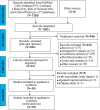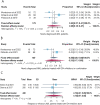Efficacy and safety of FDA-approved IDH inhibitors in the treatment of IDH mutated acute myeloid leukemia: a systematic review and meta-analysis
- PMID: 37434249
- PMCID: PMC10334617
- DOI: 10.1186/s13148-023-01529-2
Efficacy and safety of FDA-approved IDH inhibitors in the treatment of IDH mutated acute myeloid leukemia: a systematic review and meta-analysis
Abstract
Objective: To systematically evaluate the efficacy and safety of FDA-approved isocitrate dehydrogenase (IDH) inhibitors in the treatment of IDH-mutated acute myeloid leukemia (AML).
Methods: We used R software to conduct a meta-analysis of prospective clinical trials of IDH inhibitors in the treatment of IDH-mutated AML published in PubMed, Embase, Clinical Trials, Cochrane Library and Web of Science from inception to November 15th, 2022.
Results: A total of 1109 IDH-mutated AML patients from 10 articles (11 cohorts) were included in our meta-analysis. The CR rate, ORR rate, 2-year survival (OS) rate and 2-year event-free survival (EFS) rate of newly diagnosed IDH-mutated AML (715 patients) were 47%, 65%, 45% and 29%, respectively. The CR rate, ORR rate, 2-year OS rate, median OS and median EFS of relapsed or refractory (R/R) IDH-mutated AML (394 patients) were 21%, 40%, 15%, 8.21 months and 4.73 months, respectively. Gastrointestinal adverse events were the most frequently occurring all-grade adverse events and hematologic adverse events were the most frequently occurring ≥ grade 3 adverse events.
Conclusion: IDH inhibitor is a promising treatment for R/R AML patients with IDH mutations. For patients with newly diagnosed IDH-mutated AML, IDH inhibitors may not be optimal therapeutic agents due to low CR rates. The safety of IDH inhibitors is controllable, but physicians should always pay attention to and manage the differentiation syndrome adverse events caused by IDH inhibitors. The above conclusions need more large samples and high-quality RCTs in the future to verify.
Keywords: Acute myeloid leukemia; Enasidenib; IDH inhibitors; Ivosidenib; Meta-analysis.
© 2023. The Author(s).
Conflict of interest statement
The authors declare that they have no competing interests.
Figures





Similar articles
-
Efficacy and tolerability of isocitrate dehydrogenase inhibitors in patients with acute myeloid leukemia: A systematic review of clinical trials.Leuk Res. 2023 Jun;129:107077. doi: 10.1016/j.leukres.2023.107077. Epub 2023 Apr 14. Leuk Res. 2023. PMID: 37100025
-
Thrombopoietin mimetics for patients with myelodysplastic syndromes.Cochrane Database Syst Rev. 2017 Sep 30;9(9):CD009883. doi: 10.1002/14651858.CD009883.pub2. Cochrane Database Syst Rev. 2017. PMID: 28962071 Free PMC article.
-
Nivolumab for adults with Hodgkin's lymphoma (a rapid review using the software RobotReviewer).Cochrane Database Syst Rev. 2018 Jul 12;7(7):CD012556. doi: 10.1002/14651858.CD012556.pub2. Cochrane Database Syst Rev. 2018. PMID: 30001476 Free PMC article.
-
A network meta-analysis of randomized controlled trials of induction treatments in acute myeloid leukemia in the elderly.Clin Ther. 2011 Mar;33(3):254-79. doi: 10.1016/j.clinthera.2011.04.004. Clin Ther. 2011. PMID: 21600383
-
Systemic pharmacological treatments for chronic plaque psoriasis: a network meta-analysis.Cochrane Database Syst Rev. 2021 Apr 19;4(4):CD011535. doi: 10.1002/14651858.CD011535.pub4. Cochrane Database Syst Rev. 2021. Update in: Cochrane Database Syst Rev. 2022 May 23;5:CD011535. doi: 10.1002/14651858.CD011535.pub5. PMID: 33871055 Free PMC article. Updated.
Cited by
-
Monocytic Differentiation of Human Acute Myeloid Leukemia Cells: A Proteomic and Phosphoproteomic Comparison of FAB-M4/M5 Patients with and without Nucleophosmin 1 Mutations.Int J Mol Sci. 2024 May 7;25(10):5080. doi: 10.3390/ijms25105080. Int J Mol Sci. 2024. PMID: 38791118 Free PMC article.
-
Association of genetic predisposition studies in CYP1A1 polymorphism studies in acute myeloid leukemia.Saudi J Biol Sci. 2024 Mar;31(3):103917. doi: 10.1016/j.sjbs.2023.103917. Epub 2023 Dec 23. Saudi J Biol Sci. 2024. PMID: 38283773 Free PMC article.
-
The Emerging Role of CD8+ T Cells in Shaping Treatment Outcomes of Patients with MDS and AML.Cancers (Basel). 2025 Feb 22;17(5):749. doi: 10.3390/cancers17050749. Cancers (Basel). 2025. PMID: 40075597 Free PMC article. Review.
-
Mitochondrial abnormalities as a target of intervention in acute myeloid leukemia.Front Oncol. 2025 Jan 20;14:1532857. doi: 10.3389/fonc.2024.1532857. eCollection 2024. Front Oncol. 2025. PMID: 39902131 Free PMC article. Review.
-
Clinical Implications of Isocitrate Dehydrogenase Mutations and Targeted Treatment of Acute Myeloid Leukemia with Mutant Isocitrate Dehydrogenase Inhibitors-Recent Advances, Challenges and Future Prospects.Int J Mol Sci. 2024 Jul 19;25(14):7916. doi: 10.3390/ijms25147916. Int J Mol Sci. 2024. PMID: 39063158 Free PMC article. Review.
References
Publication types
MeSH terms
Substances
LinkOut - more resources
Full Text Sources
Medical

